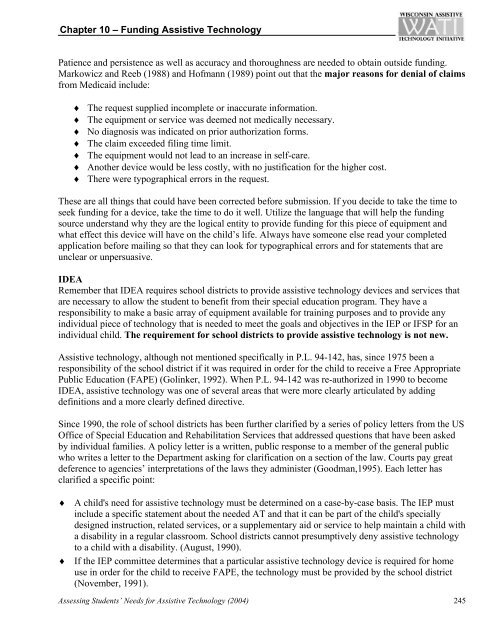Assessing Student's Needs for Assistive Technology (ASNAT)
Assessing Student's Needs for Assistive Technology (ASNAT)
Assessing Student's Needs for Assistive Technology (ASNAT)
You also want an ePaper? Increase the reach of your titles
YUMPU automatically turns print PDFs into web optimized ePapers that Google loves.
Chapter 10 – Funding <strong>Assistive</strong> <strong>Technology</strong><br />
Patience and persistence as well as accuracy and thoroughness are needed to obtain outside funding.<br />
Markowicz and Reeb (1988) and Hofmann (1989) point out that the major reasons <strong>for</strong> denial of claims<br />
from Medicaid include:<br />
♦ The request supplied incomplete or inaccurate in<strong>for</strong>mation.<br />
♦ The equipment or service was deemed not medically necessary.<br />
♦ No diagnosis was indicated on prior authorization <strong>for</strong>ms.<br />
♦ The claim exceeded filing time limit.<br />
♦ The equipment would not lead to an increase in self-care.<br />
♦ Another device would be less costly, with no justification <strong>for</strong> the higher cost.<br />
♦ There were typographical errors in the request.<br />
These are all things that could have been corrected be<strong>for</strong>e submission. If you decide to take the time to<br />
seek funding <strong>for</strong> a device, take the time to do it well. Utilize the language that will help the funding<br />
source understand why they are the logical entity to provide funding <strong>for</strong> this piece of equipment and<br />
what effect this device will have on the child’s life. Always have someone else read your completed<br />
application be<strong>for</strong>e mailing so that they can look <strong>for</strong> typographical errors and <strong>for</strong> statements that are<br />
unclear or unpersuasive.<br />
IDEA<br />
Remember that IDEA requires school districts to provide assistive technology devices and services that<br />
are necessary to allow the student to benefit from their special education program. They have a<br />
responsibility to make a basic array of equipment available <strong>for</strong> training purposes and to provide any<br />
individual piece of technology that is needed to meet the goals and objectives in the IEP or IFSP <strong>for</strong> an<br />
individual child. The requirement <strong>for</strong> school districts to provide assistive technology is not new.<br />
<strong>Assistive</strong> technology, although not mentioned specifically in P.L. 94-142, has, since 1975 been a<br />
responsibility of the school district if it was required in order <strong>for</strong> the child to receive a Free Appropriate<br />
Public Education (FAPE) (Golinker, 1992). When P.L. 94-142 was re-authorized in 1990 to become<br />
IDEA, assistive technology was one of several areas that were more clearly articulated by adding<br />
definitions and a more clearly defined directive.<br />
Since 1990, the role of school districts has been further clarified by a series of policy letters from the US<br />
Office of Special Education and Rehabilitation Services that addressed questions that have been asked<br />
by individual families. A policy letter is a written, public response to a member of the general public<br />
who writes a letter to the Department asking <strong>for</strong> clarification on a section of the law. Courts pay great<br />
deference to agencies’ interpretations of the laws they administer (Goodman,1995). Each letter has<br />
clarified a specific point:<br />
♦ A child's need <strong>for</strong> assistive technology must be determined on a case-by-case basis. The IEP must<br />
include a specific statement about the needed AT and that it can be part of the child's specially<br />
designed instruction, related services, or a supplementary aid or service to help maintain a child with<br />
a disability in a regular classroom. School districts cannot presumptively deny assistive technology<br />
to a child with a disability. (August, 1990).<br />
♦ If the IEP committee determines that a particular assistive technology device is required <strong>for</strong> home<br />
use in order <strong>for</strong> the child to receive FAPE, the technology must be provided by the school district<br />
(November, 1991).<br />
<strong>Assessing</strong> Students’ <strong>Needs</strong> <strong>for</strong> <strong>Assistive</strong> <strong>Technology</strong> (2004) 245











